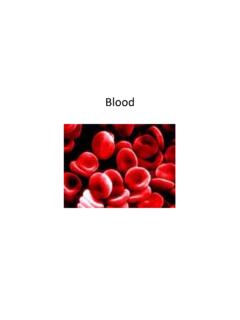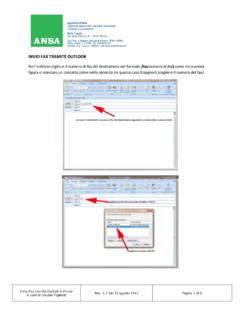Transcription of Anatomy of facial nerve - gmch.gov.in
1 Anatomy of facial nerveEmbryology of the facial nerveWeeks 0-4-3rdwk : facioacoustic (acousticofacial) primordium -4thwk : chorda tympani nerve exits rostrally and courses ventrally to the first pharyngeal pouch to enter the mandibular archWeeks 5-6-The greater superficial petrosal nerve (GSPN) is appreciable-The chorda tympani nerve enters the mandibular arch and terminates just proximal to the submandibular ganglion, near a branch of the trigeminal nerve2 Week 7 :-The chorda tympani and lingual nerve unite proximal to the submandibular gland-The parotid gland begins to develop . The temporal, zygomatic, and upper buccal branches are superficial to the parotid primordiumWeek 8 :-Beginning of the fallopian canalWeeks 10-15 :-The vertical portion of the facial nerve begins in the middle ear, and its overall relationship to external and middle ear structures is far more anterior than in the 16 to birth:- the fallopian canal develops- In late fetal life, the fallopian canal is closed by bone in most areas, except in the anterior cranial portion, where it remains open to form the facial hiatus along the floor of the middle cranial fossa.
2 -25-55 %of fallopian canals are dehiscent, with the most common location adjacent to the oval Anatomy Of facial nerve Broadly divided into 3 parts Intracranial Portion Intratemporal Portion Extratemporal Portion5 2 roots: Motor root :moderate in size Sensory root (Nervus intermedius of wrisberg)-Very slender & lies posterior to motor nerve : sensory root Special Visceral Efferent/Branchial Motor General Visceral Efferent/Parasympathetic General Sensory afferent Special Visceral Afferent/Taste8 Special sensory afferent Origin : Unipolar neurons in geniculate ganglia Central : Nucleus of Tractus Solitarius Peripheral : Chorda tympani nv & lingual nv to ant 2/3rdtongue9 General sensory afferent Deep sensibility of face10 General Visceral Efferent Origin : Sup salivatory nucleusPara sympathetic secretomotor fibres(SSN)GSPN PterygopalatineGanglia- Lacrimal & Palatine Gland(ISN)LSPN- Otic Ganglia Parotid GlandChorda Tympani Sunmandibular & Sublingual Gland11 SegmentLocationLength mmSupranuclearCerebral cortex Brain stem Brain stem to IAC24 Meatal segmentIAM to fundus5-12 Labyrinthine segmentFundus of IAC to first genu3-4 Tympanic segmentGeniculate ganglion to pyramidal eminence8-11 Mastoid segmentPyramidal process to stylomastoid foramen10-14 Extratemporal segmentStylomastoid foramen to pes anserinus15-2012 Intracranial Portion Of facial nerve14 facial nv & nerve of intermedius lie above & slightly ant to vestibulocochlear nv Distance between exit & entrance in IAC :23-24 mm15 Intratemporal portion of facial nerve fallopian canal (after Gabriel Fallopius).
3 Divided into 4 segments: Meatal Labyrinthine Tympanic, horizontal Mastoid, vertical16 Meatal Segment (5-12 mm) segment: Size -3-5 mm , mm Lies beneath the middle cranial fossa Direction Meninges 20labyrinthine segment: - meningeal cover- narrow constriction ( )- 132 deg bend Slight constriction from vertical crest , thick periosteum Only segment of the facial nerve that lacks anastomosing arterial cascades : embolic phenomena, low-flow states, or vascular compression21 Geniculate ganglion: Forming a acute angle of variable degree but usually not less than 75 . 1stgenu Cog The geniculate ganglion is formed by the junction of the nervus intermedius and the facial nerve into a common trunk22Ty m p a n i c o r horizontal segment(8-11 mm) : Geniculate ganglion to the 2ndgenu Course : inclined inferiorly forming a angle of <10 Dehiscent fallopian canal in 25-55% of postmortem window 23 Mastoid (Vertical) segment of facial canal 15-20 mm Course Angulation 3 branches28 Chorda tympani nerve Terminal branch of the nervus intermedius Course 29 Exits the fallopian canal via the stylomastoid foramen.
4 Stylomastoid foramen opens at base of petrosa between the mastoid process and styloid. Once it exit the fallopian canal at the stylomastoid foramen, it gives off several rami before it divides into its main branches30 Branches of facial of Haller (inconstant) auricular belly of digastric anserinusExtratemporal facial Nerve31 Extratemporal facial nerve Runs anteriorly in the substance of parotid gland, crosses the ECA & divides at the posterior border of ramus of mandible into 2 primary branches:32 Sup : TemporozygomaticInf : Cervicofacial After the main point of division, 5 major branches of the facial nerve exist: Temporal ( , frontal), zygomatic, buccal, marginal mandibular, and Tragal pointer Styloid process Posterior belly of digastric Peripheral branches Stylomastoid foramen Tympanomastoid suture Vaginomastoid angle Post auricular muscle branchSurgical landmarks for the extratemporal facial nerve34 Frontal branch Ramus mandibularis (post facial vein ) Buccal branch35 Vascular supply of the facial nerve The cortical motor area.
5 Rolandic branch Pons : anterior inferior cerebellar artery (AICA) Superficial petrosal artery Posterior auricular artery36 Thank U

















